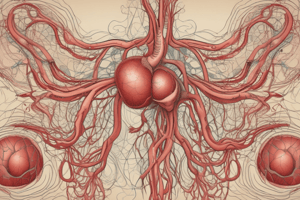Podcast
Questions and Answers
What is one of the reasons why the pulse rate increases in response to elevated body temperature?
What is one of the reasons why the pulse rate increases in response to elevated body temperature?
- Due to the decrease in blood pressure
- Due to the peripheral vasodilation associated with elevated body temperature (correct)
- Because of the increased sympathetic nervous stimulation
- Because of the increased metabolic rate
Which medication is known to decrease the heart rate?
Which medication is known to decrease the heart rate?
- Digitalis preparations (correct)
- Epinephrine
- Cardiotonic
- Atropine
What happens to the pulse rate when there is a loss of blood from the vascular system?
What happens to the pulse rate when there is a loss of blood from the vascular system?
- It remains the same
- It decreases
- It fluctuates
- It increases (correct)
Why is the temporal pulse site used?
Why is the temporal pulse site used?
What is the effect of stress on the pulse rate?
What is the effect of stress on the pulse rate?
What is the effect of position on the pulse rate?
What is the effect of position on the pulse rate?
Why is the carotid pulse site used?
Why is the carotid pulse site used?
What can affect the resting pulse rate?
What can affect the resting pulse rate?
Which of the following arteries is used to determine circulation of the foot?
Which of the following arteries is used to determine circulation of the foot?
What is the purpose of assessing the pulse?
What is the purpose of assessing the pulse?
What is the recommended time for a patient to rest before assessing the pulse?
What is the recommended time for a patient to rest before assessing the pulse?
What is the characteristic of a normal pulse?
What is the characteristic of a normal pulse?
What is tachycardia?
What is tachycardia?
Which of the following is NOT a factor that affects pulse rate?
Which of the following is NOT a factor that affects pulse rate?
What is used to assess apical pulses?
What is used to assess apical pulses?
What is the purpose of using a Doppler Ultrasound Stethoscope?
What is the purpose of using a Doppler Ultrasound Stethoscope?
What is the term for a pulse with an irregular rhythm?
What is the term for a pulse with an irregular rhythm?
What is the term for the force of blood with each beat?
What is the term for the force of blood with each beat?
What is the term for a pulse that is readily obliterated with pressure from the fingers?
What is the term for a pulse that is readily obliterated with pressure from the fingers?
What is the purpose of apical pulse assessment in patients with known cardiovascular diseases?
What is the purpose of apical pulse assessment in patients with known cardiovascular diseases?
Where is the apical pulse assessed?
Where is the apical pulse assessed?
What is the term for the movement of air in and out of the lungs?
What is the term for the movement of air in and out of the lungs?
What is the normal type of breathing?
What is the normal type of breathing?
What is the term for the intake of air into the lungs?
What is the term for the intake of air into the lungs?
What represents the stroke volume output or the amount of blood that enters the arteries with each ventricular contraction?
What represents the stroke volume output or the amount of blood that enters the arteries with each ventricular contraction?
What is the purpose of assessing a peripheral pulse?
What is the purpose of assessing a peripheral pulse?
What is the effect of age on the pulse rate?
What is the effect of age on the pulse rate?
What is an example of a peripheral pulse?
What is an example of a peripheral pulse?
What is the cardiac output (CO)?
What is the cardiac output (CO)?
What happens to the pulse rate during exercise?
What happens to the pulse rate during exercise?
What is an example of a central pulse?
What is an example of a central pulse?
Why is assessing a peripheral pulse important for clients at risk for pulse alterations?
Why is assessing a peripheral pulse important for clients at risk for pulse alterations?
Where is the apical pulse located in adults?
Where is the apical pulse located in adults?
Why is the radial pulse used in conjunction with some medications?
Why is the radial pulse used in conjunction with some medications?
At what age is the apical pulse located at the midclavicular line (MCL)?
At what age is the apical pulse located at the midclavicular line (MCL)?
Where is the femoral pulse located?
Where is the femoral pulse located?
What is the purpose of the brachial pulse?
What is the purpose of the brachial pulse?
Why is the popliteal pulse used?
Why is the popliteal pulse used?
Where is the radial pulse located?
Where is the radial pulse located?
Why is the apical pulse used in infants?
Why is the apical pulse used in infants?
Flashcards are hidden until you start studying
Study Notes
Pulse Assessment
- Two pulse sites used to determine circulation of the foot: posterior tibial and dorsalis pedis
- Posterior tibial pulse is located on the medial surface of the ankle, where the posterior tibial artery passes behind the medial malleolus
- Dorsalis pedis pulse is located on the foot, over the bones of the foot, on an imaginary line drawn from the middle of the ankle to the space between the big and second toes
Assessing the Pulse
- Pulse is commonly assessed by palpation (feeling) or auscultation (hearing)
- Middle three fingertips are used for palpating all pulse sites, applying moderate pressure (except apical pulse)
- Stethoscope is used for apical pulses
- Doppler Ultrasound Stethoscope (DUS) is used for pulses that are difficult to assess
Factors to Consider When Assessing the Pulse
- Medications that affect heart rate
- Patient's resting heart rate (e.g., physically fit athlete will have a resting heart rate below 60 beats/min)
- Position of patient (e.g., sitting position can affect heart rate)
- Baseline data about the normal heart rate
What to Obtain When Assessing the Pulse
- Rate
- Rhythm
- Volume
- Arterial wall elasticity
- Presence or absence of bilateral equality
Abnormal Pulse
- Tachycardia: excessively fast heart rate, over 100 beats/min in an adult
- Bradycardia: heart rate of less than 60 beats/min in an adult
- Dysrhythmia/arrhythmia: pulse with an irregular rhythm
Pulse Volume
- Refers to the force of blood with each beat
- Can range from absent to bounding
- A normal pulse can be felt with moderate pressure of the fingers and can be obliterated with greater pressure
Apical Pulse Assessment
- Purposes: obtain heart rate of an adult with irregular peripheral pulse or unavailable, monitor patient with cardiovascular, pulmonary, or renal diseases, and administer medications that affect heart rate
- Location: palpate the angle of Louis (angle between the manubrium and the body of the sternum) or the fifth intercostal space towards the medial to mid-clavicle line
Respiration
- Respiration: act of breathing
- Inhalation/inspiration: intake of air into the lungs
- Exhalation/expiration: breathing out or movement of gases from the lungs to the atmosphere
- Ventilation: movement of air in and out of the lungs
Types of Breathing
- Costal (thoracic) breathing: normal
- Other types of breathing: in response to lowered blood pressure or increased metabolic rate
Factors Affecting the Pulse Rate
- Medications: some decrease pulse rate, while others increase it
- Hypovolemia/dehydration: loss of blood from the vascular system increases pulse rate
- Stress: sympathetic nervous stimulation increases heart rate and force
- Position: sitting or standing can affect heart rate
- Pathology: certain diseases can alter resting pulse rate
Pulse Sites
- Temporal pulse: located on the temporal bone of the head, used when radial pulse is not accessible
- Carotid pulse: located at the side of the neck, used during cardiac arrest/shock in adults
- Apical pulse: located at the apex of the heart, used for infants and children up to 3 years old
- Brachial pulse: located at the inner aspect of the bicep muscles of the arms, used to measure blood pressure
- Radial pulse: located on the thumb side of the inner aspect of the wrist, readily accessible
- Femoral pulse: located alongside the inguinal ligament, used in cardiac arrest/shock
- Popliteal pulse: located behind the knee, used to determine circulation to the lower leg
Assessment of Patients
- Pulse: a wave of blood created by contraction of the left ventricle of the heart
- Pulse wave represents the stroke volume output or the amount of blood that enters the arteries with each ventricular contraction
- Compliance of the arteries: ability to contract and expand
Factors Affecting the Pulse
- Age: pulse rate gradually decreases with age
- Sex: average male pulse rate is slightly lower than the female pulse rate after puberty
- Exercise: pulse rate normally increases with activity
- Fever: pulse rate increases
Studying That Suits You
Use AI to generate personalized quizzes and flashcards to suit your learning preferences.




